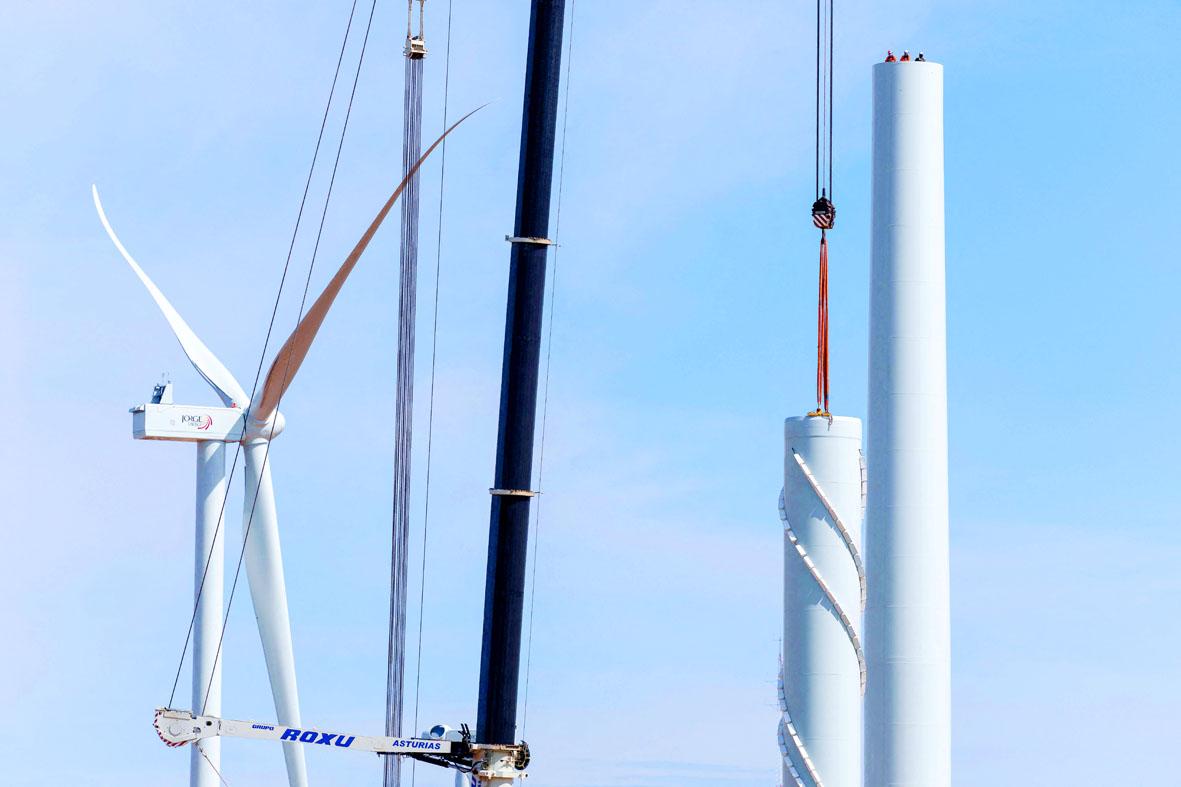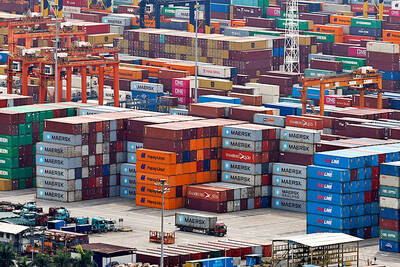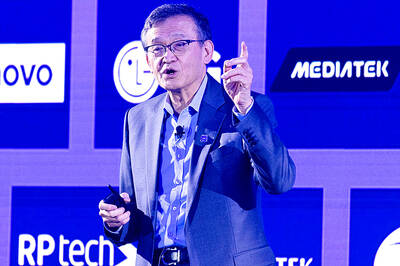Buoyed by a surge in investment and new projects, wind power has become Spain’s main source of electricity generation just as Europe seeks to curb its energy imports from Russia.
“We are on suitable ground here,” said Joaquin Garcia Latorre, project director at Enel Green Power Espana, pointing to gigantic masts erected on the heights of the tiny northeastern village of Villar de los Navarros.
The Spanish-Italian firm picked this spot, which is well exposed to the wind, to set up a 180 megawatt wind farm, one of the country’s biggest.

Photo: AFP
Dubbed Tico Wind, its 43 wind turbines started producing power in November last year, Latorre said, as workers around him tended to the turbines, which are more than 100m high.
“There are between 2,500 and 3,000 hours of wind here per year,” he added.
The wind farm would be able to produce 471 gigawatt (GW) hours per year — enough to meet the demands of 148,000 households — after it becomes fully operational in a month.
These types of projects have popped up across Spain in the past few years, making it Europe’s second-biggest wind power producer after Germany for installed capacity and the world’s fifth biggest.
Wind power became the main source of electricity production in Spain last year, accounting for 23 percent, ahead of nuclear (21 percent) and gas (17 percent), national grid operator Red Electrica de Espana said.
The sector “benefits from a favorable situation,” although “brakes” remain on its development, such as a dependency on government auctions, said Francisco Valverde Sanchez, renewables specialist at electricity consultants Menta Energia.
Following a boom in the 2000s, thanks to generous public financial aid, the sector experienced a sudden halt when subsidies were slashed in 2013 during Spain’s economic crisis.
It has since charged ahead.
Spain, which has a total of 1,265 wind farms, had an installed wind power capacity of 28.1GW last year, up from 23.4GW in 2018, the Spanish Wind Energy Association (AEE) said.
With large swathes of sparsely populated land, a favorable legal framework and cutting-edge wind turbine makers, Spain is one of the most “interesting” markets for wind power investors, AEE director-general Juan Virgilio Marquez said.
Spain is home to several sector heavyweights such as Iberdrola and Naturgay Energy Group SA, making it a top exporter of wind power equipment.
“This explains the dynamism of the sector,” Marquez said.
Investor interest has even come from outside of the energy sector.
In November last year, Spain’s Amancio Ortega, the founder of fast fashion giant Zara SA and one of the world’s richest men, injected 245 million euros (US$266.47 million) into a wind farm in the northeastern region of Aragon.
Spain in 2020 pledged to generate 74 percent of its electricity from renewable sources by 2030, up from 47 percent.
To meet this target, Spain is counting on the development of offshore wind power, a sector that is in its infancy.
As Spain has thousands of kilometers of coastline, offshore wind has lots of room to grow.
“This is an ambitious goal,” Valverde Sanchez said, adding that government bureaucracy around wind farm projects must be reduced for it to be met.
Nearly 600 wind power projects are under study by the government, AEE said.
In response to the economic fallout from Russia’s invasion of Ukraine, Spain has pledged to speed up the approval of wind power projects of less than 75 megawatts.
“Our country had enough natural resources to become Europe’s leading producer and exporter of renewable energy,” Spanish Prime Minister Pedro Sanchez said on Wednesday, adding that this could be key to helping the EU meet its goal of “energy independence.”
After Russia invaded Ukraine on Feb. 24, Brussels declared a mission to cut the EU’s Russian gas imports by two-thirds this year and to end the use of Russian gas by 2027.
Spain “could become the energy ‘breadbasket’ of Europe,” Virgilio Marquez said.

The Eurovision Song Contest has seen a surge in punter interest at the bookmakers, becoming a major betting event, experts said ahead of last night’s giant glamfest in Basel. “Eurovision has quietly become one of the biggest betting events of the year,” said Tomi Huttunen, senior manager of the Online Computer Finland (OCS) betting and casino platform. Betting sites have long been used to gauge which way voters might be leaning ahead of the world’s biggest televised live music event. However, bookmakers highlight a huge increase in engagement in recent years — and this year in particular. “We’ve already passed 2023’s total activity and

Nvidia Corp CEO Jensen Huang (黃仁勳) today announced that his company has selected "Beitou Shilin" in Taipei for its new Taiwan office, called Nvidia Constellation, putting an end to months of speculation. Industry sources have said that the tech giant has been eyeing the Beitou Shilin Science Park as the site of its new overseas headquarters, and speculated that the new headquarters would be built on two plots of land designated as "T17" and "T18," which span 3.89 hectares in the park. "I think it's time for us to reveal one of the largest products we've ever built," Huang said near the

China yesterday announced anti-dumping duties as high as 74.9 percent on imports of polyoxymethylene (POM) copolymers, a type of engineering plastic, from Taiwan, the US, the EU and Japan. The Chinese Ministry of Commerce’s findings conclude a probe launched in May last year, shortly after the US sharply increased tariffs on Chinese electric vehicles, computer chips and other imports. POM copolymers can partially replace metals such as copper and zinc, and have various applications, including in auto parts, electronics and medical equipment, the Chinese ministry has said. In January, it said initial investigations had determined that dumping was taking place, and implemented preliminary

Intel Corp yesterday reinforced its determination to strengthen its partnerships with Taiwan’s ecosystem partners including original-electronic-manufacturing (OEM) companies such as Hon Hai Precision Industry Co (鴻海精密) and chipmaker United Microelectronics Corp (UMC, 聯電). “Tonight marks a new beginning. We renew our new partnership with Taiwan ecosystem,” Intel new chief executive officer Tan Lip-bu (陳立武) said at a dinner with representatives from the company’s local partners, celebrating the 40th anniversary of the US chip giant’s presence in Taiwan. Tan took the reins at Intel six weeks ago aiming to reform the chipmaker and revive its past glory. This is the first time Tan